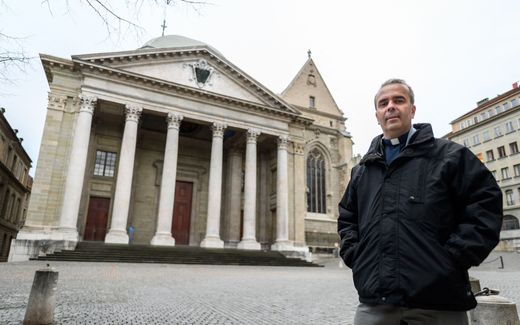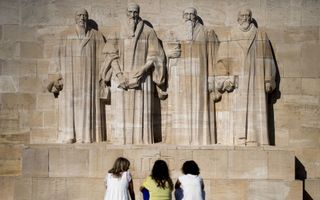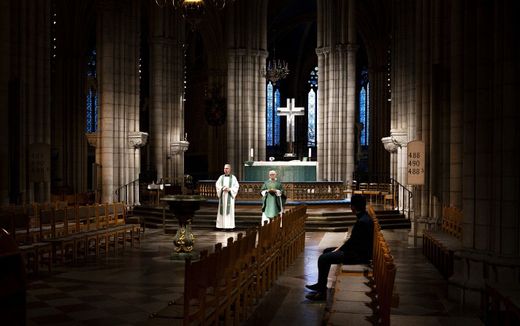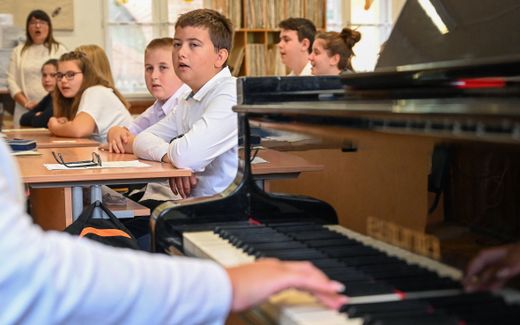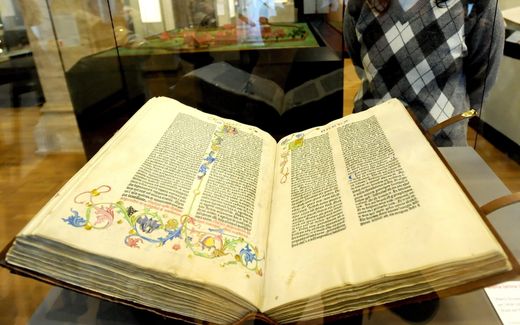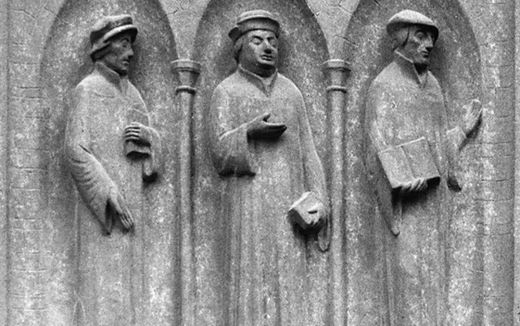After two years, the Reformation Museum in Geneva reopens
28-04-2023
Central Europe
Laura Hendriksen-Bassa, RD

John Calvin in the Reformation Monument in Geneva. Photo AFP, Fabrice Coffrini
Central Europe
Geneva is the city of the Reformation. After two years of renovation, the Reformation Museum in the Swiss city is reopening its doors. The opening ceremony took place on Wednesday evening.
Slowly, the square in front of the "Cour de Saint-Pierre" filled up Wednesday evening. Voices wave against the tall historic buildings surrounding the square. On the right is the Saint Pierre, the church of reformer John Calvin. To the left is the Reformation Museum. After two years of renovation, it reopens.
Half past six, a bell rings in the distance. Gabriel de Montmollin, director of the museum, climbs the building's steps—the murmur of over 150 guests silences.
"Welcome to the reopening celebration of the Reformation Museum. Major reforms in the Reformation Museum have marked the past 21 months. We have carried out these reforms in line with the Protestant motto, namely that a reformed church must reform permanently."

World Council
The Musée International de la Réforme (MIR) opened its doors in 2005. One of the initiators for the museum is the World Council of Churches (WCC), whose headquarters are also in Geneva. The Swiss city played an essential role during the Reformation.
The Reformation Museum, housed in Maison Mallet, a former monastery, highlights that influence, focusing not only on Calvin but also on Beza, Zwingli and Luther.
Hourglass
On 2 August 2021, the museum closed for a major renovation. The main entrance moves from Rue du Cloître to Cour de Saint-Pierre, on the other side of the building. The museum is also expanding. In addition to permanent exhibitions, there is now space for temporary exhibitions. During the closure, visitors can take a virtual museum tour via the website.
On Wednesday evening, the opening ceremony takes place for guests. In addition to staff from the Reformation Museum, executives from other Geneva museums are present. De Montmollin explains what has happened in the past 21 months. "In our museum, you will find new objects, including an hourglass. This comes from a historical museum in the Netherlands, once a Reformed and Calvinist country. It was placed next to the pulpit of a Dutch preacher to indicate a limit to his speaking time. The authorities feared that political considerations would have a place in too long sermons."
Epicentre
Geneva is no longer the epicentre of the Reformation. The number of Calvinists in Geneva is not large, explains MIR director Gabriel de Montmollin.
The director of the Reformation Museum has had some busy days. On Thursday, the first visitors discovered the new collections after two years of renovation. De Montmollin enjoys talking about the exhibitions in his office opposite the museum.

Does the Reformation Museum focus mainly on Calvin?
"No, we are an international museum and do not focus only on Calvin. However, one of the ten rooms in the museum is dedicated to him. We count Calvin among the second generation of Reformers. Therefore, in addition to him, we also draw attention to Luther, Zwingli and Melanchthon. The museum further highlights countries that played an important role in the history of the Reformation."
Which countries?
"France, for example. Because of the Huguenot War, many Protestants fled the country. Therefore, during the 17th century, there were only French pastors in Geneva. Calvin often taught them.
The Netherlands also played an important role. For instance, we have a picture hanging of the Synod in Dordrecht. There they met to discuss the doctrine of predestination and election. This was an important theme in Calvin's theology.
After the 17th century, the Reformation spread further, including to America. The explanations in the museum will be available in nine languages from next week to be truly internationally focused."
How did the people of Geneva view Calvin?
"Many people were pleased with him, but he had to leave Geneva after two years because he was very strict. People wanted the freedom of the Reformation. Later he was asked to come back anyway. The authorities needed a person who could be strict. Geneva was full at that time. The city, surrounded by walls, doubled in population due to the large number of refugees taking up residence there. The city expanded by building in height.

Calvin imposed many restrictions. He was a difficult man to deal with; he was straightforward. He should be seen as a man of his time. Coming out for your faith could be incredibly dangerous. That's why you had to fight for your opinion. The reformer abolished Catholic festivals, meaning Geneva residents had fewer days off. Not everyone was happy about that. He, therefore, also had many opponents."
How do the people of Geneva view Calvin today?
"When the Reformation Wall was built in 1909, it was intended that a statue of Calvin only would be placed there. The inhabitants of Geneva did not want that because they viewed Calvin negatively. After all, he is mostly seen as a moralistic person. People from abroad are generally more positive about Calvin than those here in the city."
How many visitors does the museum get per year?
"Before the renovation, about 25,000 visitors came every year. Now we hope for around 30,000 or 35,000 people."

This article was originally published in the Dutch Reformatorisch Dagblad and here on April 28th, 2023.
Related Articles


